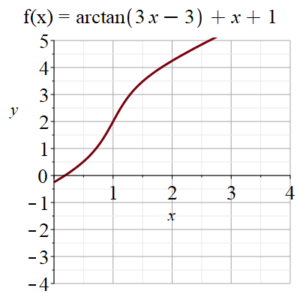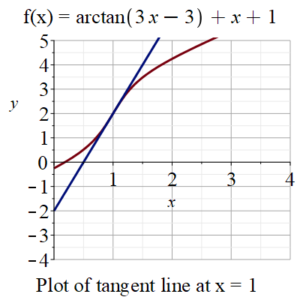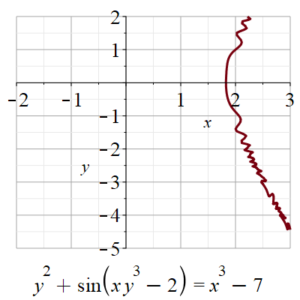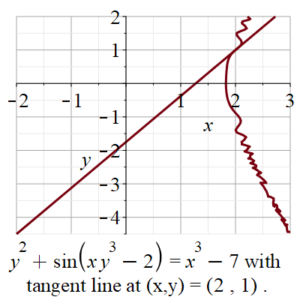Welcome to my Mat 301 Calculus I site!
Quiz 2
Sample Questions
Question 1

The graph of is shown above. Find the equation of the tangent line to
at at
. Then, to get credit for Question 1, find the
intercept of that tangent line to the nearest thousandth (3 decimal places).
Put the coordinate of the
intercept on the line below.
Recall, the intercept of the tangent line is where
the tangent line crosses the axis.
Answer to Question 1: the
Videos (3 parts) on how to solve Question 1.
Part 1. Starting the problem and finding .
Part 2. Evaluating
Part 3. Extra material. Finding the
Answer to Question 1: the
Note. Here is a graph of that tangent line:

The following Maple commands will solve Question 1 and create the graph shown above. You can copy and paste the following commands into Maple.
restart;
with(plots):
f := x -> arctan(3*x - 3) + x + 1;
"Find tangent line equation at";
x0 := 1;
xStart := 0:
xFinish := 4:
yStart := -4:
yEnd := 5:
TangentLine := (f, x0, x) -> D(f)(x0)*(x - x0) + f(x0):
"tangent line equation y = mx +b";
evalf(TangentLine(f, x0, x));
"x intercept";
solve(evalf(TangentLine(f, x0, x)), x);
plot([f(x), TangentLine(f, x0, x)], x = xStart .. xFinish,
y = yStart .. yEnd, gridlines, size = [0.6, 0.6],
title = typeset("f(x) = ", f(x)), thickness = 7,
caption = typeset("Plot of tangent line at x = ", x0));
Question 2

Using implicit differentiation find the equation of the tangent line to the graph of:
which is shown in the above figure, at the point .
Answer to Question 2: the
Videos (6 parts) on how to solve Question 2.
Part 1. Review of the tangent line equation in the context of implicitly defined functions.
Part 2. Finding .
Part 3. Finding ;
.
Part 4. Evaluating .
Part 5. Evaluating
Part 6. Finding the x intercept (which solves the Question 2). In part 6, as an extra, I explain how to find the y intercept and how to graph the tangent line equation.
Answer to Question 2: the
Note. Here is a graph of that tangent line:

The following Maple commands will solve Question 2 and create the graph shown above. You can copy and paste the following commands into Maple.
restart:
with(plots):
implicit_f := y^2 + sin(x*y^3 - 2) = x^3 - 7;
x0 := 2;
y0 := 1;
xstart := -2:
xfinish := 3:
ystart := -5:
yfinish := 2:
"Check that (x0, y0) satisfies the implicit relation";
subs({x = x0, y = y0}, implicit_f);
implicit_diff_f := implicitdiff(implicit_f, y, x);
"tangent line equation y = mx + b at (x0, y0)";
m := evalf(subs({x = x0, y = y0}, implicit_diff_f));
b := -m*x0 + y0;
xintercept := -b/m;
implicitplot({implicit_f, y = m*x + b},
x = xstart .. xfinish, y = ystart .. yfinish, thickness = 10,
grid = [100, 100], gridlines, thickness = 3, rangeasview = true,
size = [0.4, 0.7],
caption = typeset(y^2 + sin(x*y - 2) = x^3 - 7,
"and its tangent line at (", x0, ",", y0, ")."));
Question 3
You want to build a rectangular frame enclosing the maximum amount of area.
The top and bottom of the frame are going to be made out of gold (cost $ \$ $60 per centimeter) and the two sides of the frame are going to be made out of silver (cost $ \$ $4 per centimeter). You have $6,000 to spend. Find the maximum area your frame can enclose
to the nearest thousandth (three decimal places).
Video on how to solve Question 3. See end of the video for answer.
Question 3 is an example of what is called a constrained optimization problem. We want to optimize (maximize) the area enclosed by the frame subject to the constraint of our budget being limited to $6,000.
Question 4
If
the nearest thousandth (three decimal places).
Make sure your calculator is set to radian measure.
Your answer should be a single number like
-9.123 or 8.789.
Video on how to solve Question 4. See end of the video for answer.
To solve Question 4 you need to know the following derivative formulas:
Chain rule:
Power rule:
Combining the power rule with the chain rule give us:
Question 5
If
the nearest thousandth (three decimal places).
Your answer should be a single number like
-9.123 or 8.789.
Video on how to solve Question 5. See end of the video for answer.
Question 6
Suppose .
Your answer should be a single number like
-9.123 or 8.789.
Video (in two parts) on how to solve Question 6.
See end of the Part II video for answer.
Part I
Part II
Notes.
When we do implicit differentiation we assume that that y can be written as a function of x, in other words,
Some examples:
An example which uses the product rule:
Question 7
Suppose
Your answer should be a single number like
-9.123 or 8.789.
Video on how to solve Question 7. See end of the video for answer.
To solve Question 7 you need to know the following derivative formulas:
.
.
.


